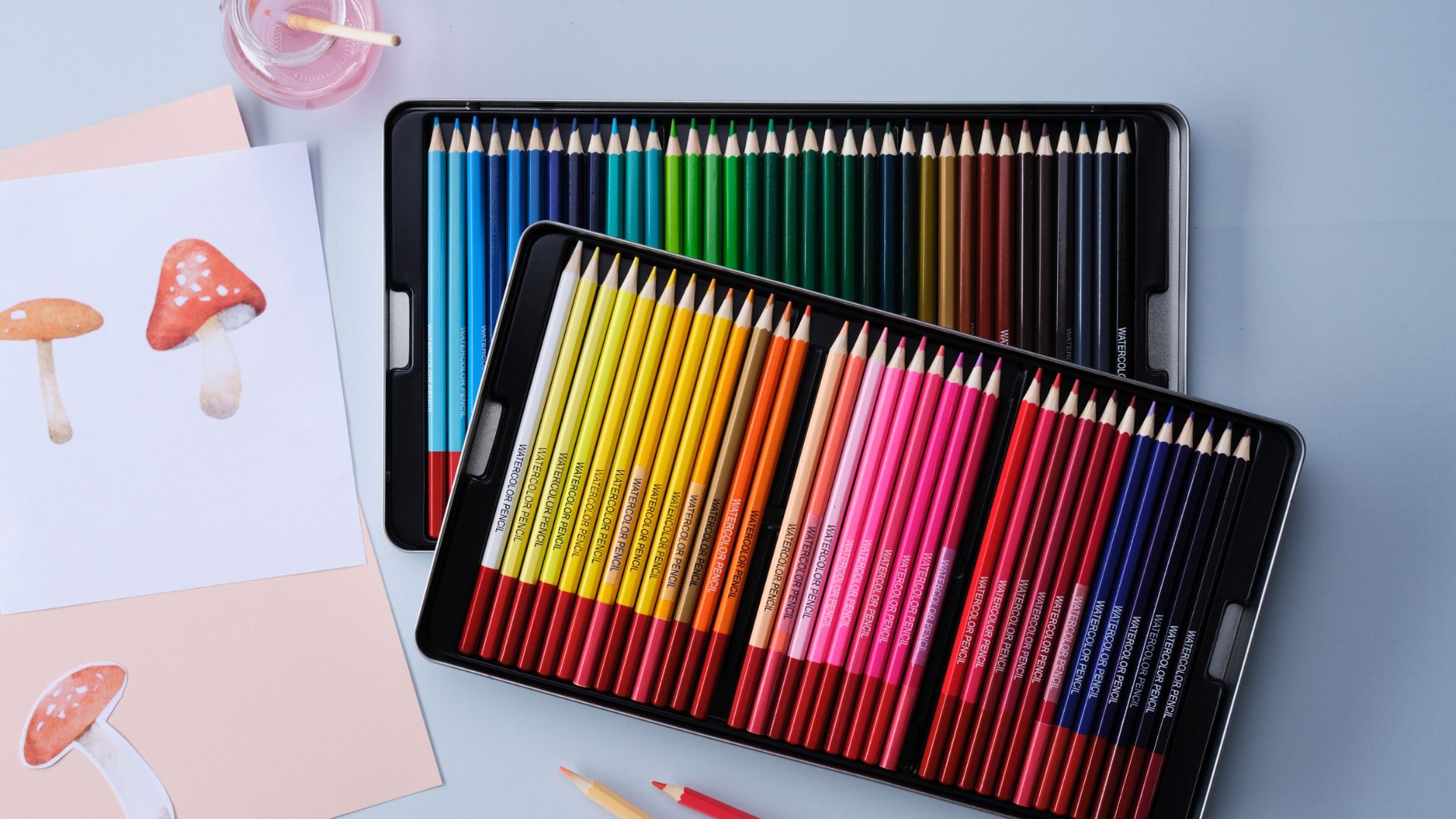 | ||
| Your browser is not supported. | ||
|
Please browse our site using any of the following options:
| ||
How To Use Watercolour Pencils

What do you get when you combine the ease of use and level of detail available using a pencil with the glowing colours and blendability of watercolour paints? The answer is the watercolour pencil, an amazing art tool that is much loved by both beginner and experienced artists!
At Spotlight we've got a beautiful range of watercolour pencil sets available, but how do you take the first step into this exciting (but slightly confusing) hybrid medium? For those of you curious about using watercolour pencils this guide will walk you through everything you need to know about the supplies you need, some watercolour pencil ideas and different watercolour pencil tips, tricks and techniques to keep in mind. Let's learn how to use watercolour pencils together!
Quick Links
- What Are Watercolour Pencils?
- What Do I Need To Use With Water Soluble Pencils?
- How To Use Watercolour Pencils
- Watercolour Pencil Ideas
- Watercolour Pencil Tips And Tricks
What Are Watercolour Pencils?
You may be asking, what are watercolour pencils… because they look just like my regular colouring pencils! And at first glance, they look just like your everyday coloured pencils. The key difference is how the pigment has been bound - in regular pencils, the binding agent is usually a type of wax or oil - this keeps the pigments waterproof and strong on the page. But in a watercolour pencil the pigment is water-soluble, which means the pigment disperses when it comes into contact with water.
Otherwise, watercolour pencils have the same wooden barrel and comfortable grip you would get from your average coloured pencil. If you love the feel of a pencil in your hand but are keen to try out using a brush for painting, watercolour pencils are a fantastic creative medium to dabble with!
What Do I Need To Use With Water Soluble Pencils?
To start with, grab yourself a simple 13-pack of watercolour pencils. Even low-quality pencils will still create nice effects on paper, so don't feel pressured to buy the most expensive water soluble pencil set you can find. You will also need:
- Watercolour paper (cold pressed, hot pressed or rough)
- Watercolour paintbrushes (a medium-sized synthetic round and flat will do)
- Cup of water
- Paper towel
- Pencil sharpener
And that's all you need! Watercolour pencil artwork doesn't require a bulky palette or odorous additives like other art mediums, so it's an inexpensive choice if you love making art but don't love the costs often associated with producing quality artwork.
How To Use Watercolour Pencils
Now you've got what you need, how do you use watercolour pencils? There are many ways you can apply your watercolour pencil to paper, but the most popular way is to use the pencil on a dry sheet of paper, then add water later (dry on dry). Here are some basic steps you can follow when drawing with watercolour pencils:
- Use a grey lead or a pale watercolour pencil to lightly sketch the outline of your subject onto your watercolour paper. Grey lead linework won't blend away like a water-soluble pencil's linework will, but it is faint enough that it shouldn't show through your layers anyway.
- Use watercolour pencils to colour any background areas of your image first. Leave blank any of the areas you want to be white.
- Load your brush with a little water and apply it to your background colour - watch as the colours blossom and brighten! Fill in your background slowly, cleaning the brush between colour changes and making sure not to rub the brush into the paper, as this can cause it to pill and even tear..
- Wait for the background to dry before adding additional layers or moving onto the main part of your artwork.
- Start colouring your main subject. If you don't want your light and dark colours to mix, add your lighter colours first, add water and let dry before doing the same with your darker ones.
- If you wish to add any fine linework or details, finish up with some dry pencil lines, then only add a tiny bit of water to soften them up.
This is only a very basic rundown on how to use watercolour pencils - for more helpful tips, tricks and subject ideas, read more below!

Watercolour Pencil Ideas
If you're stuck on what exactly you want to draw, try some of these watercolour pencil ideas for inspiration!
Beginner watercolour pencil ideas
If you are just beginning to use water soluble pencils, start off drawing simple-shaped objects in bright colours and with minimal texture.
- Round fruits - the combination of bright colours and a soft, rounded shape make this subject great for beginners. A red apple, purple grapes or some yellow lemons and green limes all make for great opportunities to practice blending colours and linework without having to worry about background or visual texture.
- Leaves - take some inspiration from your own backyard and try drawing some leaves on a branch! Whether it's autumn leaves in reds, oranges and browns or fresh spring leaves in green and yellow, their unique curving shapes are fun to draw, and they provide a good chance to blend colours and add a little texture.
- Flowers - the gorgeous colours of flowers can be replicated with watercolour pencils to great effect, plus you can use dry pencil lines for any delicate details and petal edging you need. If you are feeling confident, add curving stems in green to contrast against your flowers!
Advanced watercolour pencil ideas
Once you are comfortable using water soluble pencils, try drawing more complicated scenery and subjects with lots of texture and differing colours.
- Lakeside - watercolours are always a strong choice for drawing any body of water, so take advantage of this with a beautiful lakeside scene! Contrast the blue of the water with a green, grassy shoreline and maybe even a few mountains in the distance in cool greys and purples for an amazingly picturesque painting.
- Your pet - drawing animals is a great way to practice drawing texture using watercolour pencils, so why not try drawing your own pet? Practice fur with dogs or cats, feathers with budgies or parrots or scales with a turtle or lizard. Keep in mind your dry techniques to really show off the texture of your pet!
- Weathered home - a homestead with plenty of character is the perfect way to combine your texture, colour, shape and background colouring skills with watercolour pencils.
Watercolour Pencil Tips And Tricks
Here are some useful techniques and tricks you can try out using watercolour pencils!
- Take colour directly from the pencil tip using a wet paintbrush if you want faint colour with no trace of pencil lines.
- Blend colours by filling a space with two blocks of colour that meet in the middle. Wet your brush and brush over the colours from one side to the other - watch as they blend together in the middle!
- Create a new colour by laying down a layer of one colour, then another over the top. Wet your brush and activate the colours, which will all blend into a new hue.
- Use masking tape or fluid to block off areas you want clean, white space in before you start drawing. It will be easy to peel or rub off once you're done, and will leave a pure white space that would be hard to achieve otherwise.
Wet and dry variations
- Dry on dry - the most common way of using watercolour pencils that we went through above. It involves using dry watercolour pencils on dry paper and adding water later on, and results in clean lines and (sometimes) noticeable pencil marks.
- Dry on wet - lightly wet your paper and then draw straight onto it with a dry pencil. This will result in blooming, bright colours with plenty of texture. Make sure to finish what you want to draw before your paper dries!
- Wet on dry - dip your pencil into water like a paintbrush and draw directly into dry paper. Your pencil will create a thick and boldly-coloured line, although your pencil will dry out quickly so you will need to re-dip a lot. Make sure to dry your pencil after use so water doesn't soak into the wooden barrel.
- Wet on wet - using a wet pencil on wet paper creates fuzzy, spreading lines and blooming colours much like watercolour paint. You'll see a lot of texture and vibrant colour, but your lines may behave in unpredictable ways!

Enjoy Using Watercolour Pencils With Spotlight
Excited to start using watercolour pencils? Discover amazing watercolour pencil sets at Spotlight online, where you can shop online and have them home delivered in just a few clicks. Alternatively, visit your nearest Spotlight store and our friendly team will help you find all the watercolour pencils you need!
Why not try creating this watercolour jellyfish using watercolour pencils instead of paints? And if you choose to take the leap into full watercolour painting, check out this amazing guide to watercolour painting for beginners.




